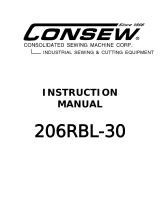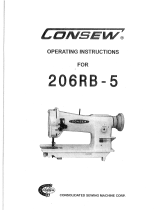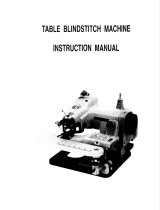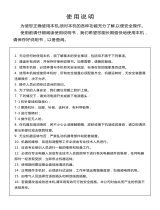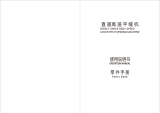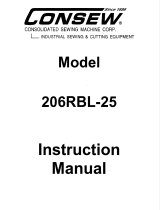SunStar KM-1062BL-7 User manual
- Category
- Sewing machines
- Type
- User manual
This manual is also suitable for

USER’S
MANUAL
KM-1060BL Series
KM-1060BL
KM-1060BL-7
KM-1062BL
KM-1062BL-7

Best Quality
Best Price
Best Service
R
1.
Thank you for purchasing our product. Based on the rich expertise and
experience accumulated in industrial sewing machine production, SUNSTAR
will manufacture industrial sewing machines, which deliver more diverse
functions, high performance, powerful operation, enhanced durability, and
more sophisticated design to meet a number of user’s needs.
2. Please read this user’s manual thoroughly before using the machine. Make
sure to properly use the machine to enjoy its full performance.
3. The specifications of the machine are subject to change, aimed to enhance
product performance, without prior notice.
4.
This product is designed, manufactured, and sold as an industrial sewing
machine. It should not be used for other than industrial purpose.

Safety rules for machines
1. Specifications
1) Sewing machine
2) Motor
3) Peripheral automation devices (optional)
2. Installation
1) Oil fan
2) Machine head
3) Belt tension adjuster
4) Belt cover
5) Program unit (thread trimming type)
6) Air pressure-related parts and functions (thread trimming type)
7) Thread spool stand assembly
8) Knee-lifting pad (thread non-trimming type)
9) Lubrication check
10) Check for stop position of the sewing machine (thread trimming type)
11) Back tack button (thread trimming type)
12) Check for switch functions (thread trimming type)
3. Operation and functions of the Servo motor
1) Operation and control of the pedal
2) Setting potentiometer
4. Control and adjustment of the sewing machine
1) Inserting a needle
2) Inserting/separating a bobbin
3) Winding lower thread
4) Routing upper thread
5) Thread tension adjustment
6) Adjustment of the stitch length
7) Adjustment of lifting amount of main and auxiliary presser foot
8) Pressure adjustment of the presser foot
9) Timing adjustment of needle and feed dog
10) Height adjustment of feed dog
11) Timing adjustment of needle and hook
12) Clearance adjustment of hook and opener
13) Position adjustment of hook needle guard
14) Height adjustment of the auxiliary presser foot
15) Timing adjustment of mainauxiliary presser foot and needle
16) Adjustment of the thread trimming device
17) Adjustment of the thread tension release
18) Lubrication adjustment of hook
19) Replacement of the gauge
5. Cause of troubles and troubleshooting
1) Sewing machine troubleshooting
6. Table drawing

4
Safety rules for machines
Safety labels in the manual are categorized into danger, warning and caution. Failure to follow the safety
rules may result in physical injuries or mechanical damages. The safety labels and symbols are defined
as follows.
The meaning of the safety marks
Instructions here shall be observed strictly. Otherwise, the user will be killed or
suffer severe physical injuries.
Instructions here must be observed, or the user could suffer fatal or severe
physical injuries.
Instructions here should be observed, or the user could face physical injuries or
mechanical damages.
Danger
Warning
Caution
The meaning of marks
This mark means a must-not
This mark means a mustfor safety
This mark means that an electric shock may be caused if the instruction is not
followed properly.

5
1-1) Machine mobilization
Danger
1-2) Machine installation
Caution
1-3) Troubleshooting
Danger
When the machine is in need of repair, only our authorized service technicians must
handle it.
Only personnel with a full understanding of the safety rules should move the machines.
The following directions must be observed when delivering the machines.
Physical damages such as functional difficulties or breakdowns may occur depending on
installation conditions of the machines. Be sure to heed the following conditions.
[Note] Details of the machine installation are laid out in No. 2 Installation.

6
1-4) Machine operation
Warning
1-5) Safety device
Warning
KM-1060BL Series are intended to be used for industrial purposes for sewing textiles and
other similar materials. Carefully study the following instructions before operating the
machine.
Caution
Always start the machine with safety covers in place since
fingers or hands could be injured or cut off by the belt. Turn off
the power switch when conducting a regular check on the
machine.

7
Cautionis attached on the machine for safety. Read the directions of cautioncarefully before
running the machine.
1-6) Location of caution mark
1-7) Contents of caution
[Location of caution mark]

8
1
Description KM-1060BL-7 (trimming type) KM-1060BL KM-1062BL
KM-1062BL (Trimming type)
1) Sewing machine
Specifications
Application
Maximum stitch length
Stroke distance of needle bar
Lifting amount of presser foot
Needle type
Hook type
Reverse sewing
Feeding device
Lubrication
Specifications of bed
Power supply
Medium heavy to very heavy material
9mm
33.8mm
Maximum of 7 mm
DP x 17 #22 (#14~#25)
Horizontal hook
Reverse button & lever Reverse lever Reverse button & lever Reverse lever
Total feeding (needle, feed dog, upper feed presser foot)
Automatic oil supply
568 x 178 mm (working space of 300 mm)
Description
Lifting amount of the main and sub presser foot
Sewing speed
Sewing speed
1
2
3
4
1.0 mm~2.4 mm
2.5mm3.9mm
4.0mm4.7mm
4.8mm7.0mm
3500spm
3000spm
2500spm
2000spm
Note) 1. The sewing speed automatically changes by the default value of the lifting amount of the main and sub presser foot (trimming type)
2. When using the stitch length longer than 6mm, set the sewing speed at under 2,000 spm in the program unit box.
3. Since automatic speed control is not available for non-trimming types, the sewing speed must be controlled manually at the value shown in the table
above. When using the stitch length longer than 6mm, be sure to set the sewing speed at under 2,000 spm to avoid mechanical damages.
2) Motor
Watt
550 W
550 W
550 W
Hertz
50/60 Hz
50/60 Hz
50/60 Hz
Model
Voltage
110V / 220V
220V / 380V
Watt
400W
400W
Hertz
50/60Hz
50/60Hz
Model
S3M55-1B
S3M55-2B
S3M55-3B
Voltage
Single Phase 110V
Single Phase 220V
Triple Phase 220V
1 phase 110/220 V
3 phase 220V
1 phase 110V/220V
3 phase 220V
1 phase 110/220V
3 phase 220V/380V
1 phase 110/220V
3 phase 220V/380V
ApplicationUseModelName
Production Counter
Material edge sensor
Standing pedal
SEDG-1
SEDG-2
SPDL-1
SPDL-2
A device that senses the edge or thickness of the sewing
material to stop the machine without manual pedaling.
Available in two types: SEDG-1 for edge sensing type and
SEDG-2 for thickness sensing type.
A device needed when only one operator runs several
sewing machines. Pedals for acceleration, thread trimming,
presser foot and ascending are built separately. Two types,
SPDL-1 and EDPL1 for fixed speed type and SPDL-2 and
EDPL-2 for adjustable speed type are available.
Basic type PU
Basic Type PU/
Option Type PU
SCOUN-1
A counting device which indicates the completed quantity
on the program unit panel, including added, subtracted,
corrected or remaining quantity along with other
performance rates.
Basic type PU
3) Peripheral automation devices (optional)
Servo Motor
470 Motor

9
2
Installation
1) Oil fan
Fix oil tray and oil tank from the accessory box onto oil
fan as shown in the Figure 1, then secure the oil fan under
the table using six nails.
2) Machine head
Nail the rubber cushion onto hinge rubber and four
edges, then install the head hinge in the sewing machine
with the head inserted in the bed.
[ Fig. 1 ]
[ Fig. 2 ]
Warning
The machine must be installed by a trained technician only.
Any electrical wiring must be performed by a qualified technician or agent.
The machines weigh over 52 kg. As such, two or more people should carry out the installation.
Plug in only after the installation is complete. If the operator mistakenly steps down on the pedal
with the plug in, the machine will start automatically and can cause physical injuries.
Connect the ground (earth) wire. An unstable connection may result in an electric shock or a
malfunction.
Place the belt cover on top of the machine
Use both hands when bending the machine backward or returning it to the normal position.
Using only one hand can lead to physical injuries due to the weight of the machine.

10
4) Belt cover
A. Insert the head groove of belt cover support screw into
the lower grooves of the belt cover A. Fix the belt
cover onto the machine body and the top cover with two
belt cover fixing screws.
B. After placing the belt cover B into the belt cover A
, secure it onto the machine body using three belt cover
fixing screws.
5) Program unit (thread trimming type)
A. Use four fixing screws to attach the bracket onto the
program unit.
B. Fasten the bracket onto the machine body, using two
fixing screws and washers.
[ Fig. 4 ]
[ Fig. 5 ]
[ Fig. 6 ]
3) Belt tension adjuster
After installing the motor, slacken both fixing nuts and
just enough to give adequate tension to belt. Firmly tighten
the fixing nuts and consecutively.
[ Fig. 3 ]

11
6) Air pressure-related parts and functions (thread trimming type)
A. Installation
a) Use a screw to fix the pneumatic unit
onto the lower side of the table as illustrated in the Fig.
b) Connect five pneumatic tubes from right to left as shown in the Fig. Tie the tube with other lead lines using band clip
.
Automatic presser foot-lifting cylinder
S1P
S2P
S5S
S3L
S3R
CylinderLabel mark
Reverse sewing cylinder
Conversion cylinder of
lifting amount of presser foot
Conversion cylinder for stitch length
[ Fig. 7 ]
Function
Converts the lifting amount of the main and auxiliary
presser foot to the maximum 7 mm in an instant
Performs reverse sewing
Raises the presser foot to as high as 16 mm off the
surface of needle plate
Performs sewing in accordance with the settings of the
lower stitch length dial when this particular cylinder
begins to run among two stitch length dials of the
machine
Caution
When it becomes necessary to regulate the machine with the power on or with the air injected,
exercise extreme caution for safety.
Set the air pressure at 0.5 Mpa.

12
7) Thread spool stand assembly
B. Adjustment of pneumatic pressure
a. Adjust the pressure by pulling knob from pneumatic
filter.
b. Control the pneumatic pressure at 0.49 MPa (5kgf/cm
)
and put the knob back to its original position..
Secure the thread spool stand assembly onto the table using
washer and nut on the right side.
8) Knee-lifting pad (thread non-trimming type)
A. Place the socket of the knee-lifting pad (assy) from the
accessory box into the knee-lifting shaft.
B. Loosen the bolt to set a position comfortable for knee
lifting and then re-tighten it.
[ Fig. 8 ]
[ Fig. 9 ]
[ Fig. 10 ]
[Caution]
Take out the knee-lifting pad (assy) before pushing
the machine backward.

13
A. Bed part
Loosen oil cap screw to fill up the oil tank to the gauge
line of the oil gauge. Afterwards, tighten the screw
firmly.
B. Face plate
Dismantle the facet by unfastening two fixing screws of the
facet and add the sewing machine oil into an arrow
position. Reassemble the facet afterwards.
9) Lubrication check
[ Fig. 11 ]
[ Fig. 12 ]
Caution
Plug in only after oil supply is finished. If the operator mistakenly steps on the pedal with the
plug in, the machine will start automatically and can cause severe injuries.
When handling lubricants, wear protective glasses or gloves to avoid contact with your eyes or
skin. Inflammation may be caused otherwise. Never drink lubricants since they can cause
vomiting or diarrhea. Keep it out of the reach of children
Operate the machine only after adding oil when the machine is being used for the first time or
has been left unused for a long time.

14
Check for the machine stop position after moving the needle
up and down by pushing the reverse button. See if the sign
Bis shown on the window of the belt cover when the
needle stops in an up position. If not, adjust the position of the
magnetic holder embedded in the pulley, for trimming
function can be adversely affected when the position is not
adequate.
10) Check for stop position of the sewing
machine (thread trimming type)
D. Oil window check
After applying oil to each friction parts, turn on the main
switch and operate the machine at a low speed for five
minutes to check the oil flow in the oil hose passing the oil
window. The oil flow can be checked after about one
minute of machine operation. To ensure the machine is
maintained in an excellent condition, run the machine at
2,000 spm/minute for the first 4~5 days and at a normal
speed afterwards.
[ Fig. 14 ]
[ Fig. 15 ]
C. Hook part
Open the slide plate (right) to add the sewing machine
oil into an arrow-pointed position. Close the slide plate
after oiling.
[ Fig. 13 ]

15
B. Check for down-stop position of needle bar
The down-stop position of needle bar is where the carved
sign of the needle bar coincides with the tip of the needle
bar frame. If the position is not suitable, move the
magnetic holder built in a carved N.D. sign of the pulley
to the left and right for adjustment.
[ Fig. 17 ]
Pressing the back tack button or reverse button during
forward sewing will start reverse sewing immediately. When
you stop the machine and restart it by stepping down on the
pedal with the reverse button already pressed down, you can
perform reverse sewing from the beginning. When the
machine is in a stopmode, you can change up-down
position of the needle bar by pressing the reverse button.
Lightly pressing the button once will stop the needle bar in a
high position. Pressing the reverse button twice within less
than a second will stop the needle bar in a low position. In
short, the button delivers two functions: one for reverse sewing
and the other for converting vertical position of the needle.
11) Back tack button (thread trimming type)
[ Fig. 18 ]
A. Check for up-stop position of needle bar
The up-stop position of needle bar is where the take-up
lever stops 2mm off of its highest position. For
adjustment, move the magnetic holder built in a carved
N.U. sign of the pulley to the left and right.
[ Fig. 16 ]

16
12) Check for switch functions (thread trimming type)
Fig. 19
: Conversion switch for presser foot lifting level
- When you press this switch, the light will come on.
The lifting amount of the presser foot will
automatically change to the maximum 7 mm
regardless of what the set-up data is in the top
cover dial. When you press the switch back, the
light will go off and the sewing machine will run at
the setting value as displayed in the top cover dial.
: Automatic back tack (B/T) selection switch
- This switch is designed to select Insert/Delete of
the start and end of B/T sewing.
: Switch for stopping needle bar at high position
- designed to raise the needle bar to the highest
position regardless of the stop position of the
sewing machine
: Conversion switch for the stitch length
- While this switch is on, the machine will run at
the setting value of the lower dial and when off,
the machine will operate at the setting value of
the upper dial.

17
1) Operation and control of the pedal
A. Loosen fixing nut and turn pressure-adjusting screw
in a clockwise direction as shown in Figure 20. The
machine will start running at a backward step 1. The pedal
will become heavier when the automatic presser foot is
raised. Likewise, the pedal will become lighter when the
screw is shifted in a counterclockwise position. After
adjusting the weight of the pedal, firmly tighten the fixing
nut.
B. Unfasten the fixing nut and turn the pressure-adjusting
screw clockwise, then the machine will begin to run at a
backward step 2. The pedal will become heavier when the
trimming device begins to operate, and lighter when the
screw is turned counterclockwise.
C. In adjusting the pedal pressure while sewing forward,
secure the tension spring onto the left side groove to
decrease pressure and onto the right side groove to increase
pressure.
D. Pedal operation
You can perform various functions with the sewing
machine by moving the pedal (foothold) forward and
backward as illustrated below.
Function
Low-speed
operation
High-speed
operation
Neutral position
Presser foot lift
Trimming operation
When pedal is pressed down at forward step 1
When pedal is pressed down to
the maximum in forward position
When pedal is not pressed down
(Original position)
When pedal is pressed down
at backward step 1
When pedal is pressed down
at backward step 2
Machine rotates at a low speed
Machine rotates at a high speed
Machine stops
Presser foot is lifted
Trimming device starts running
and cuts the thread
Pedal position Peal operation Sewing machine operation
Fig. 20
For more detailed information on operation and functions of the Servo motor, please refer to our manual
Fortuna Ac Servo Motor Series III provided by SunStar.
3
Operation and functions of the Servo motor

18
Press and button to move to parameter number 27
Turn the dial for adjusting presser foot lifting amount and set it
at 2.5 (mm)
Set at 2.5 (mm) and press the button. The screen will
automatically change with a buzzer sound
Set at 4.0 (mm) and press button. The screen will
automatically change with a buzzer sound
Set at 4.8 (mm) and press button to change the screen
with a buzzer sound
Turn the dial again to set at 4.0 (mm)
Turn the dial once again to set at 4.8 (mm)
After setting is complete, push button to go back to the
initial screen
Sewing initial screen
Initial screen for parameter group A
P1 setting screen for group A item 27
When dial is turned, the value will be displayed
on
When dial is turned, the value will appear
on
When dial is turned, the value will be displayed
on
P2 setting screen for Group A item 27
P3 setting screen for group A item 27
Setting is complete
Sewing initial screen
2) Setting potentiometer
How to set
Relation between presser foot lifting amount and maximum speed of the sewing machine
When setting each step of P1, P2 and P3, be sure to press button to save the set value. Otherwise, the set value will not be saved.
The
sign from screen 3 to 8 in the above table may vary to some degree depending on the location of the installed potentiometer.
If you turn off the power before completing step 9, you will have to start over again.
The set value of the potentiometer will be erased if you initialize. Initialize only when it is necessary. Remember that you have to reset
the potentiometer after initialization.
If the potentiometer connector is not linked or the cable is cut, OV will be displayed on the screen.
Presser foot lifting amount
1.0 - 2.5 mm
2.5 - 4.0 mm
4.0 - 4.8 mm
4.8 - 7.0 mm
Maximum speed of the sewing machine
3500 spm
3000 spm
2500 spm
2000 spm (adjustable from group A item 20)
DetailsScreen displayHow to operate
Turn on the power
Press button, then press button while holding down
button to change screen
Sequence
1
2
3
4
5
6
7
8
9
10

19
4
Control and adjustment of the sewing machine
1) Inserting a needle
With the needle groove facing left as shown in the [Figure
21], insert the needle tip into the upper end of stopper hole
and fasten the needle with clamp screw.
A. How to separate
Hold the needle at the highest position. Press the slide
plate stopper, open the slide plate and hold up the bobbin
case holder of hook to take out the bobbin.
B. How to insert
IInsert thread-winded bobbin into the bobbin case.
Pull the lower thread out by dropping it through the thread
path
and the bottom of the shaft tension spring plate.
Let the lower thread hang about 50 mm. Place back the
bobbin by referring to How to separate, starting from end
to beginning.
2) Inserting/separating a bobbin
[ Fig. 21 ]
[ Fig. 22 ]
[ Fig. 23 ]
Caution
Always turn off the power when mounting a needle. If the operator mistakenly steps on the
pedal while the power is on, the machine will start automatically and can result in physical
injuries.
When using clutch motor, be aware that the motor will continue to rotate for a while even after
the power is switched off due to inertia. Start to work on the sewing machine only after the
motor has come to a complete stop.

20
3) Winding lower thread
A. How to wind the lower thread
a) Turn the thread from the backside of the tension
adjusting plate to the front through the hole.
b) Bring the thread towards the bobbin
and wind it 5~6
times in a clockwise direction, starting from the bottom up.
c) Push the lever to make the pulley touch the V-belt
and start the machine
d) When the lower thread is winded up completely on the
bobbin, the pulley will automatically separate from
the V-belt.
e) The adequate quantity of lower thread winding is
about 80%.
B. Winding adjustment for lower thread
a) If the lower thread winds irregularly, loosen the screw to move it left and right. Fasten it back after adjustment.
b) Winding quantity of the lower thread can be adjusted by turning the adjusting screw. Move the screw clockwise for more
quantity and counterclockwise for less quantity.
c) As for adjusting the tension of the lower thread winded on the bobbin, turn the nut clockwise direction to increase the tension and
counterclockwise to reduce the tension.
4) Routing upper thread
After placing the take-up lever in its highest position, hang the upper thread as shown in the figure.
-For initial sewing, the suitable length of the upper thread tail from the needle hole is about 50 mm.
[ Fig. 24 ]
[ Fig. 25 ]
Caution
Turn off the power switch when routing the upper thread. If the operator mistakenly presses
down on the pedal while switched on, the machine will start automatically and can cause
physical injuries.
When using the clutch motor, be aware that the motor will continue to rotate for a while after the
power is switched off. Start to work on the sewing machine only after the motor has come to a
complete stop.
Page is loading ...
Page is loading ...
Page is loading ...
Page is loading ...
Page is loading ...
Page is loading ...
Page is loading ...
Page is loading ...
Page is loading ...
Page is loading ...
Page is loading ...
Page is loading ...
Page is loading ...
Page is loading ...
Page is loading ...
Page is loading ...
Page is loading ...
Page is loading ...
Page is loading ...
Page is loading ...
-
 1
1
-
 2
2
-
 3
3
-
 4
4
-
 5
5
-
 6
6
-
 7
7
-
 8
8
-
 9
9
-
 10
10
-
 11
11
-
 12
12
-
 13
13
-
 14
14
-
 15
15
-
 16
16
-
 17
17
-
 18
18
-
 19
19
-
 20
20
-
 21
21
-
 22
22
-
 23
23
-
 24
24
-
 25
25
-
 26
26
-
 27
27
-
 28
28
-
 29
29
-
 30
30
-
 31
31
-
 32
32
-
 33
33
-
 34
34
-
 35
35
-
 36
36
-
 37
37
-
 38
38
-
 39
39
-
 40
40
SunStar KM-1062BL-7 User manual
- Category
- Sewing machines
- Type
- User manual
- This manual is also suitable for
Ask a question and I''ll find the answer in the document
Finding information in a document is now easier with AI
Related papers
-
SunStar KM-815 KM-825 User manual
-
SunStar KM-380BL User manual
-
SunStar KM-341BL User manual
-
SunStar KM-590BL User manual
-
SunStar KM-250 Series User manual
-
SunStar SC-700B User manual
-
SunStar KM-1170BLX-7 User manual
-
SunStar KM-1072 SERIES User manual
-
SunStar KM-640BL-7 User manual
-
SunStar KM-235A User manual








































